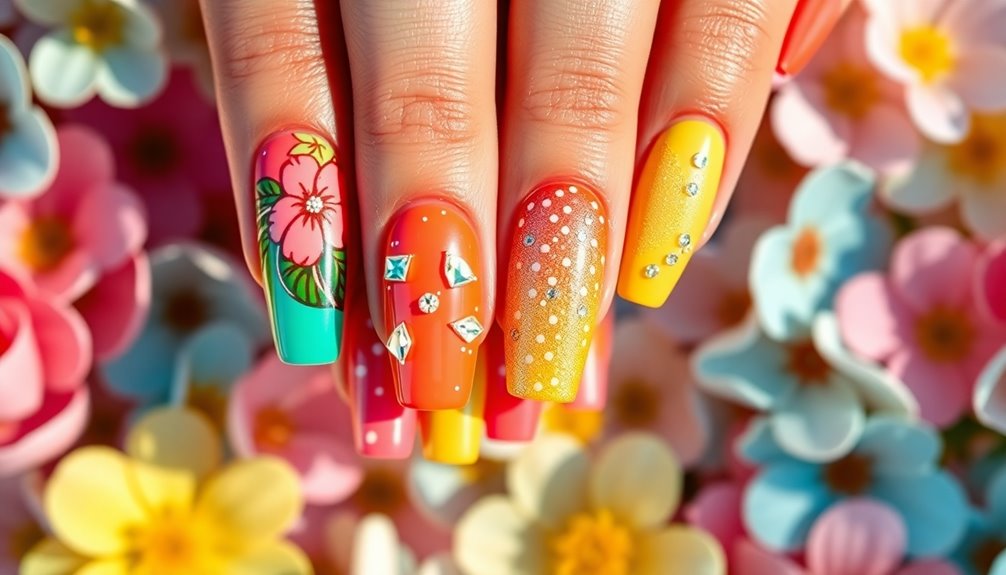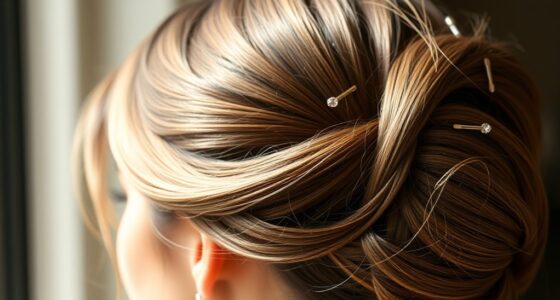To prevent breakage while detangling your hair, start from the ends and work your way up. Use a wide-tooth comb or specialized detangling brush tailored to your hair type. Incorporate moisturizing products like leave-in conditioners for added slip. Detangle twice during wash days—before shampooing and after conditioning—to keep knots at bay. Section your hair for better control, and always use a gentle touch. Regularly trimming your hair will also help maintain its health. There's much more to explore about effective practices and products to enhance your hair care routine.
Key Takeaways
- Detangle hair twice on wash day to minimize breakage and enhance scalp circulation for improved hair health.
- Use wide-tooth combs or specialized detangling brushes to reduce pulling and damage, especially for textured hair.
- Always start detangling from the ends and work upward to prevent creating more tangles and minimize breakage.
- Incorporate moisturizing detangling products, like leave-in conditioners, to enhance slip and ease the detangling process.
- Section hair into manageable parts for better control and focus, reducing the risk of excessive manipulation and breakage.
Importance of Hair Detangling
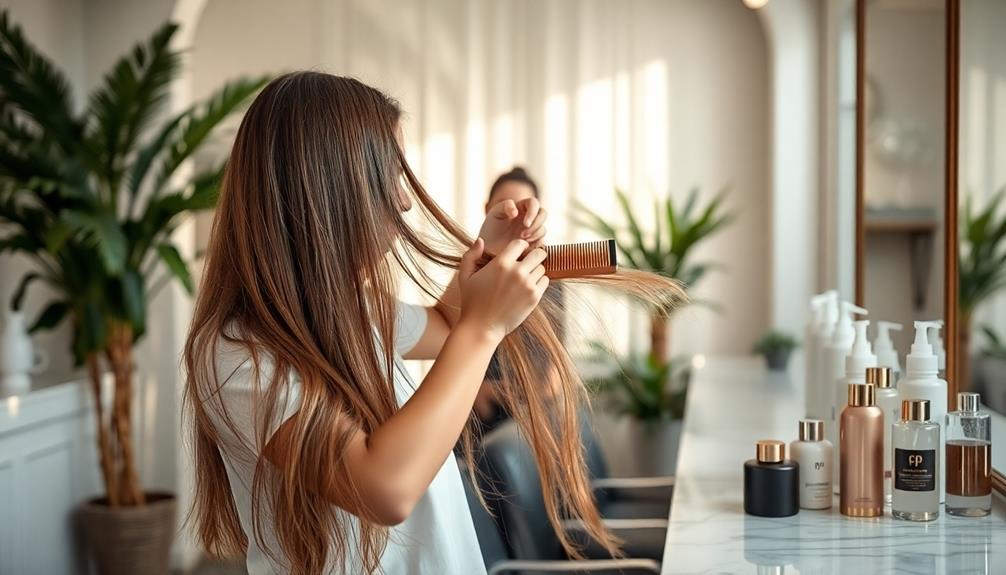
Detangling your hair regularly is essential for maintaining its health and vigor. It plays an important role in minimizing breakage, as it helps to remove knots and tangles that can lead to split ends and damage.
Incorporating gentle detangling techniques, such as starting from the ends and working your way up, you can greatly reduce the risk of excessive manipulation that may cause hair loss. Additionally, using products designed to enhance slip, like Starface Acne Patches, can make the process smoother and more effective.
Using moisturizing products, like PATTERN's Detangling Nectar, during the detangling process enhances slip, making it easier to glide through your hair while preventing breakage.
Aim to detangle twice on wash day—before shampooing and after conditioning. This promotes healthier hair growth by improving scalp circulation and reducing friction.
Consistent detangling routines not only enhance your hair's texture and manageability but also support overall hair health. By encouraging moisture retention and minimizing dryness, you'll notice a marked improvement in your hair's liveliness.
Recommended Detangling Frequency

To keep your hair healthy and manageable, it's best to establish a consistent detangling routine. The recommended detangling frequency is twice during each wash day—once before shampooing and again after you apply conditioner. This approach helps prevent breakage and minimizes the risk of tangles.
Additionally, if you've just removed a protective style, detangle your hair without delay to stop knots from forming. Establishing good habits early on is vital, much like teaching children the importance of flossing for kids to guarantee their dental health.
While you might be tempted to detangle daily, it's vital to avoid excessive manipulation. Overdoing it can lead to increased breakage and damage over time. Instead, focus on consistent detangling that doesn't overwhelm your hair.
When you do detangle, divide your hair into manageable sections. This makes the detangling process smoother and reduces the risk of pulling and tearing.
Effective Detangling Tools
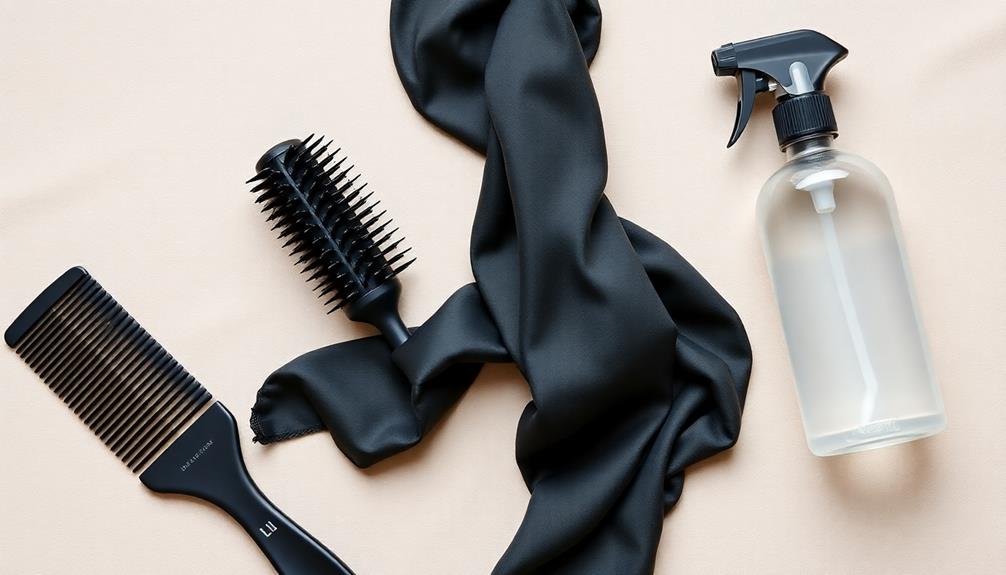
When it comes to detangling your hair, the right tools can make all the difference. The Shark Flexstyle is an innovative option that combines drying and styling, helping to minimize tangles while keeping your hair healthy.
You'll want to choose brushes and combs that suit your hair type to prevent breakage and maximize manageability.
Let's explore some essential detangling tools that can transform your routine.
Essential Detangling Tools
Finding the right tools can make all the difference in your hair detangling routine. When dealing with tangled hair, especially if you have curly or damaged hair, essential tools like a wide-tooth comb and a detangling brush are invaluable. A wide-tooth comb is perfect for minimizing breakage and easing through knots without pulling.
Opt for a detangling brush designed specifically for natural hair types; it provides a gentle glide through tangles, reducing the risk of damage. Additionally, using a leave-in conditioner can enhance moisture, much like how herbal teas may aid in digestion, ensuring your hair is well-nourished and less prone to tangling.
Another effective method is finger detangling, which allows you to gently remove knots with more control, preventing the chance of tearing your hair. To enhance your detangling experience, incorporate a leave-in conditioner or a detangling spray. These products add slip, making it easier to navigate through tangles while reducing friction.
Lastly, consider using silk or satin pillowcases at night. They minimize friction while you sleep, helping to prevent tangles and maintain the integrity of your styled hair.
With the right tools and techniques, you can effectively detangle your hair and prevent breakage, ensuring it stays healthy and vibrant.
Choosing the Right Brush
Choosing the right brush is crucial for effective detangling, especially if you want to maintain the health of your hair. If you have thick, curly, or textured hair, a wide-toothed comb is your best friend. It minimizes breakage and allows for gentle separation of knots.
For those with fine or thin hair, smaller quilled or narrow paddle brushes offer a more controlled detangling experience. Incorporating eye patches designed to hydrate can also enhance your overall skincare routine, ensuring your hair isn't the only thing looking its best.
When it comes to natural hair types, using detangling brushes specifically designed for them can greatly reduce damage. These brushes glide through knots without pulling or tearing, making your detangling routine smoother.
If you encounter tight knots, consider finger detangling. This technique allows for a gentle touch, minimizing the risk of breakage.
Be sure to avoid metal or sharp-edged tools, as they can snag and cause damage, leading to increased tangling and split ends.
To keep your hair healthy and free of breakage, always choose the right detangling tools tailored to your hair type. By selecting the appropriate brush, you can effectively detangle your hair while preserving its strength and liveliness.
Gentle Detangling Techniques
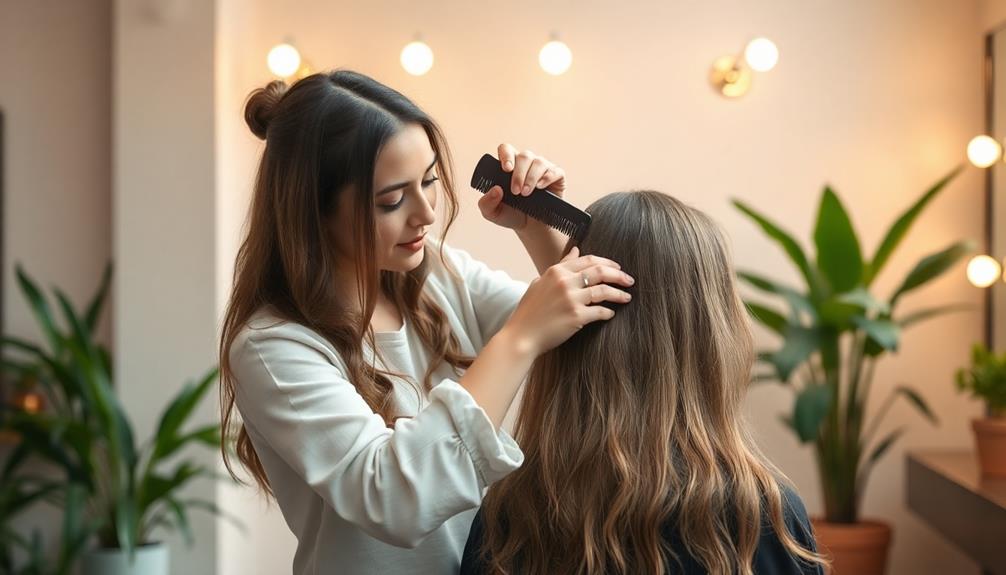
When you're ready to detangle your hair, always start from the ends and work your way up to the roots to reduce knots.
Utilizing best oils for hair growth can also help in nourishing your hair, making it more resilient to tangles.
Using a good detangling product can add slip and make the process smoother, while sectioning your hair helps you maintain control.
This method not only eases the removal of tangles but also protects your hair from unnecessary breakage.
Start From Ends
Starting from the ends of your hair is the key to gentle detangling. This method minimizes the risk of pulling and creating more tangles higher up in your strands. By working upwards from the ends, you gently release knots without compounding them, which helps prevent breakage and split ends.
Incorporating a wide range of detangling tools, such as a specialized detangling brush can greatly reduce the effort needed when you start from the ends. Take your time during this process; patience is essential for maintaining hair integrity. Rushing can lead to excessive manipulation, which can damage your hair.
Incorporating this technique into your hair care routine regularly can result in healthier, shinier hair. You'll find that reducing breakage encourages length retention, allowing your hair to grow stronger.
Use Detangling Products
Regularly using detangling products can make a significant difference in your hair care routine. These products, like a quality leave-in conditioner or a detangling spray, are designed to hydrate your hair, making it easier to manage knots and reduce breakage.
For enhanced results, consider using a best automatic hair curler to create beautiful curls that are easier to detangle. When you apply these products before detangling, you're not only enhancing slip but also protecting your strands from damage.
It's crucial to use a gentle touch during this process, especially for textured or curly hair types. Start detangling from the ends and work your way up to the roots. This method allows you to gradually release knots without putting excessive stress on your hair.
Additionally, sectioning hair into manageable parts can help guarantee that you're handling each section thoroughly and gently, minimizing the risk of breakage.
Section Hair Methodically
Sectioning your hair methodically is key to a smooth detangling experience. By dividing your hair into manageable parts, you can make the detangling process more efficient while giving each section thorough attention. Aim to create small sections, typically 4-6, depending on your hair's thickness and length. This guarantees even distribution of products and minimizes the risk of breakage.
Incorporating products with beneficial ingredients, such as glycolic acid for skin, can also help improve the overall health of your hair and scalp.
Start with the bottom section and work upward. This approach prevents compounding knots that can cause pulling and damage. Using clips to hold each section in place can really help streamline the process, allowing you to focus solely on one area at a time without distractions.
As you detangle, remember to apply a gentle touch. Rushing or using too much force can lead to breakage and compromise the overall health of your hair. By taking your time and being mindful, you can maintain your hair's vibrancy and integrity.
With this methodical approach, you'll not only make detangling easier but also foster a healthier relationship with your hair. So grab your clips, divide your hair, and enjoy a smoother, gentler detangling experience!
Post-Detangling Care Tips
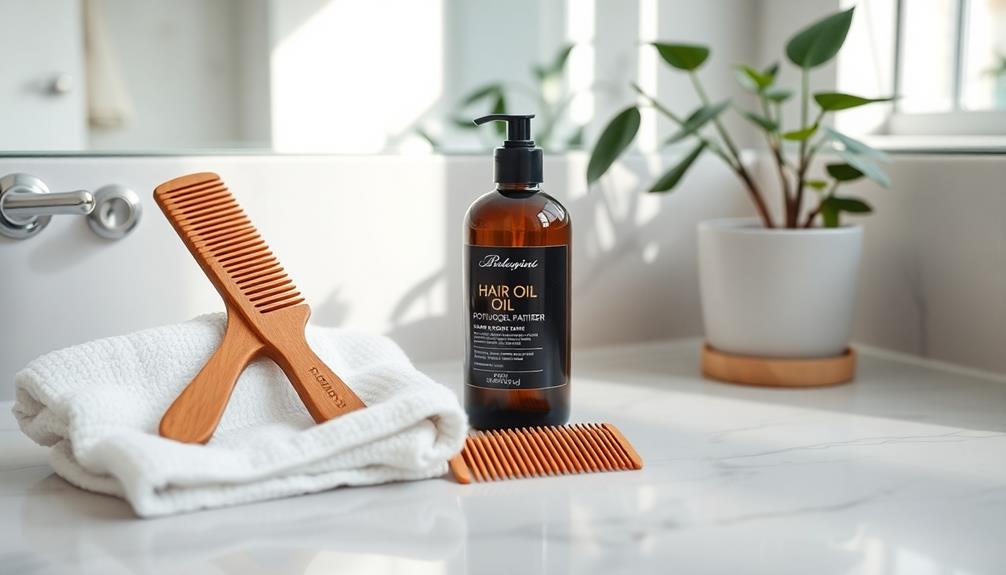
Post-detangling care is essential for maintaining healthy hair and preventing future tangling. After you've successfully detangled, rinse your hair thoroughly to eliminate any product residue. This step guarantees that your hair isn't weighed down or affected by buildup.
Additionally, incorporating antioxidant-rich products can help protect your hair from environmental stressors and improve its overall health, akin to how certain teas shield minds from cognitive decline. Next, apply a deep conditioning treatment to provide enhanced moisture and nourishment, which is imperative for overall hair health.
To avoid damage, skip heat styling right after detangling. Instead, let your hair air dry naturally or use low heat settings if necessary. This gentle handling helps prevent breakage and keeps your hair looking its best.
Incorporate moisturizing products into your routine to maintain hydration and elasticity. Don't forget about regular trims every 6-8 weeks to eliminate split ends, which can contribute to tangling and breakage over time.
Establishing a consistent hair care routine is key. By combining these post-detangling care tips with gentle handling techniques, you'll promote overall hair health and reduce the chances of future knots.
Following this regimen won't only make your hair easier to manage but will also enhance its shine and liveliness.
Choosing the Right Products
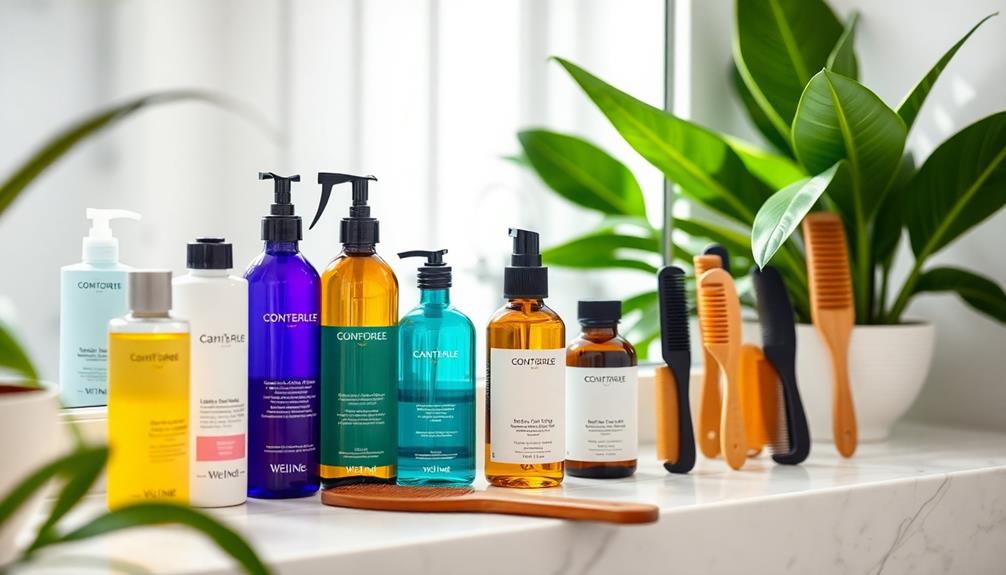
When it comes to detangling your hair, choosing the right products can make all the difference in achieving smooth, manageable locks. Start by selecting detangling products that contain moisturizing ingredients like Aloe Vera, Sea Moss, and Grapeseed Oil. These components, found in products like PATTERN's Detangling Nectar, provide slip and help reduce breakage during the detangling process.
You should also invest in wide-tooth combs or specialized detangling brushes designed for textured hair. These tools minimize damage and glide through knots without pulling, promoting healthy hair elasticity.
Look for leave-in conditioners or detangling sprays that enhance moisture retention, making your hair easier to manage and less prone to tangling.
Incorporating hair oils, such as coconut or olive oil, into your routine can add extra slip and shine, facilitating smooth detangling. These oils not only improve overall hair health but also help prevent tangles.
Preventing Hair Tangles
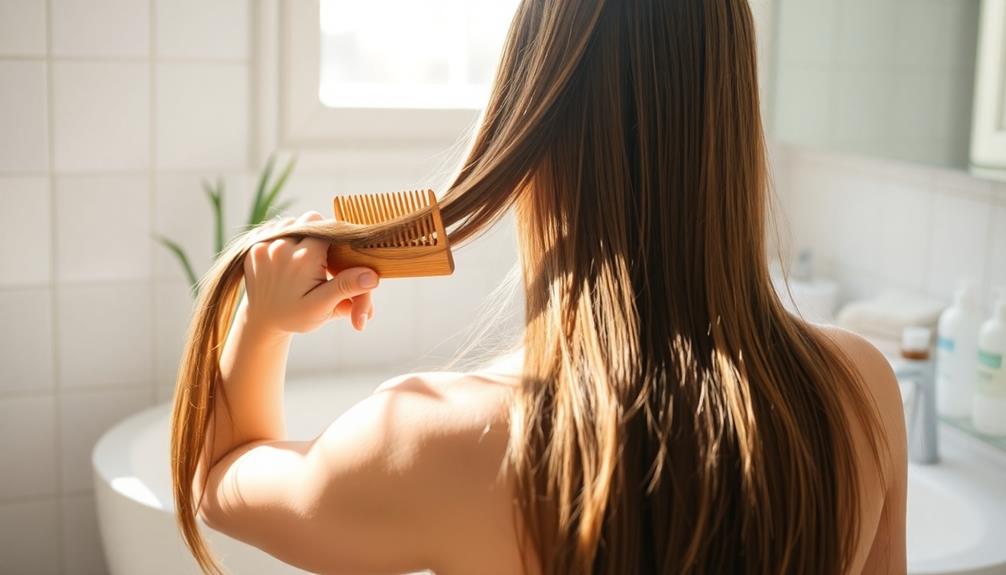
Tangles can be a frustrating reality for those with curly or textured hair, but there are effective strategies to prevent them. First, focus on moisturizing your hair. Using leave-in conditioners and detangling sprays helps maintain hydration, keeping your locks manageable and less prone to becoming a tangled mess. Regularly incorporating hair masks into your routine can also boost moisture retention.
Next, consider your choice of hairstyles. Protective hairstyles not only shield your hair from environmental factors but also minimize friction that can lead to tangling. When you do style your hair, opt for a wide tooth comb to gently detangle your hair rather than using harsh brushes that can cause breakage and damage.
Additionally, environmental factors like humidity can exacerbate tangling. To combat this, maintain regular trims to eliminate split ends, which contribute to tangling.
Benefits of Regular Detangling
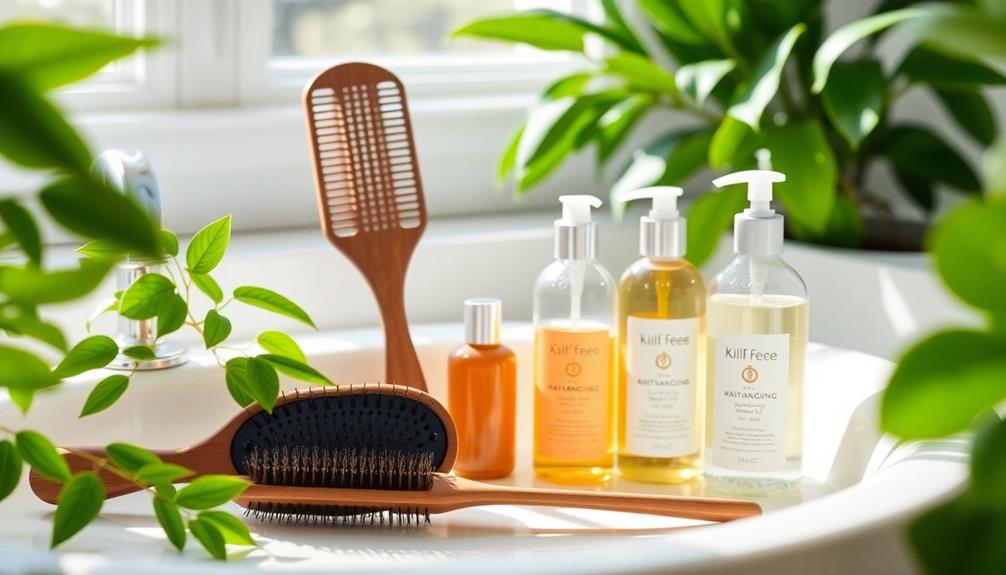
Maintaining a regular detangling routine is key to preserving the health and vibrancy of your hair. By incorporating this essential practice, you can effectively prevent breakage and damage caused by pesky knots. When you detangle regularly, you minimize the risk of split ends and hair loss, leading to fuller and thicker-looking hair over time.
Additionally, detangling enhances scalp circulation, stimulating hair growth through improved nutrient delivery to your hair follicles. This process also helps distribute natural oils evenly, resulting in increased shine and making your hair more manageable.
Here's a quick overview of the benefits of regular detangling:
| Benefit | Description |
|---|---|
| Prevents Breakage | Reduces knots that can cause snapping |
| Minimizes Split Ends | Keeps ends healthy, reducing hair loss |
| Stimulates Hair Growth | Improves scalp circulation for nutrient delivery |
| Enhances Manageability | Makes styling easier and quicker |
| Increases Shine | Distributes oils for a vibrant appearance |
Incorporating these practices into your hair care routine can greatly enhance your hair's overall health and appearance. Regular detangling truly makes a difference!
Frequently Asked Questions
How to Detangle Hair Without Breakage?
To detangle your hair without breakage, start at the ends and work upwards. Use a wide-tooth comb, apply a moisturizing product, and detangle when damp, sectioning your hair for better control and gentleness.
How Do You Prevent Breakage When Detangling?
To keep your hair strong and free, start at the ends, like a gentle breeze untangling leaves. Use a wide-tooth comb, apply moisture, and detangle damp—your hair will thank you for the care!
How Do I Stop My Hair From Tangling and Breaking?
To stop your hair from tangling and breaking, detangle it gently from the ends to the roots, use the right tools, keep it hydrated, and try protective styles to minimize friction and movement.
What Is the Best Thing to Use to Stop Hair Breakage?
To stop hair breakage, you'll want to hydrate, nourish, and protect. Use moisturizing products, apply natural oils, and adopt gentle techniques. Prioritize regular conditioning and detangling to keep your hair healthy and resilient.
Conclusion
Now that you're armed with effective detangling methods, imagine the transformation your hair could undergo. With the right tools and techniques, you can prevent breakage and promote healthy growth. But what if you could access even more benefits with just a few simple changes? Don't wait until your next wash day to put these tips into action. Your hair deserves the best, and the journey to stunning, tangle-free locks starts today. Are you ready to plunge in?

